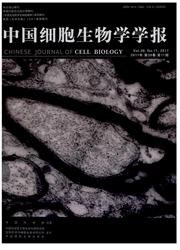

 中文摘要:
中文摘要:
为获得能够用于构建嗜热四膜虫蛋白定位的载体,该研究将GFP基因与镉(Cd2+)诱导的四膜虫金属硫蛋白基因(MTTl)启动子序列和终止子序列融合,获得表达载体pXS75-GFP。通过同源重组和抗性筛选,pXS75-GFP载体携带的目的基因整合入四膜虫MTTl位点,在cd2+诱导下实现GFP融合蛋白的可控表达。将α-tubulin基因ATUl克隆JN-pXS75-GFP中,重组质粒pXS75-GFP-ATUl通过基因枪转化入四膜虫细胞,在巴龙霉素筛选下获得稳定的α-tubulin-GFP过表达细胞株。激光共聚焦显微镜观察α-tubulin.GFP的定位,结果显示,α-tubulin—GFP融合蛋白在四膜虫细胞中表达并分布于皮层上,表明pXS75.GFP载体可用于嗜热四膜虫功能蛋白的定位分析。
 英文摘要:
英文摘要:
To construct a vector for studying the localization of protein in Tetrahymena thermophila, GFP expression vector pXS75-GFP was constructed by ligating GFP with Cd2+inducible metallothionein (MTT1) promoter and terminator sequences. The target gene-GFP fusion gene can integrate into the MTT1 locus through homologous recombination and resistance screening. Expression of the target protein in-fusion with the α-terminal GFP tag was controllable by Cd2+. The recombinant plasmid pXS75-GFP-ATU1 was constructed and biolistically transformed into Tetrahymena. The expression of α-tubulin-GFP was analyzed by Western blot. Confocal microscopy showed that α-tubulin-GFP localized at cortex in living and fixed Tetrahymena cells. The results revealed that pXS75-GFP can be used for studying the subcellular localization of proteins in Tetrahymena thermophila.
 同期刊论文项目
同期刊论文项目
 同项目期刊论文
同项目期刊论文
 Expression of Metallothionein MTT1 and MTT2 from Tetrahymena thermophila Exposed to SO2, NaCl and Tr
Expression of Metallothionein MTT1 and MTT2 from Tetrahymena thermophila Exposed to SO2, NaCl and Tr The zinc finger protein Zfr1p is localized specifically to conjugation junction and required for sex
The zinc finger protein Zfr1p is localized specifically to conjugation junction and required for sex Localization and functional analysis of HmgB3p, a novel protein containing high-mobility-group-box d
Localization and functional analysis of HmgB3p, a novel protein containing high-mobility-group-box d 期刊信息
期刊信息
